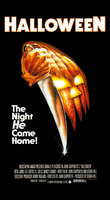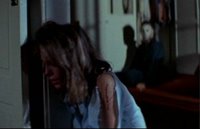 So much has been said about John Carpenter's HALLOWEEN and it's place in modern horror history that it seems ridiculous to write a new review of it now, especially considering this is the first time I've ever seen it, and have already been witness to its influence in the dozens of films that came after it. So instead I'll stick to some brief thoughts about what I liked as I watched.
So much has been said about John Carpenter's HALLOWEEN and it's place in modern horror history that it seems ridiculous to write a new review of it now, especially considering this is the first time I've ever seen it, and have already been witness to its influence in the dozens of films that came after it. So instead I'll stick to some brief thoughts about what I liked as I watched.The movie begins in the point of view of young Michael Myers who, for no discernible reason, picks up a butcher's knife, walks upstairs, and brutally murders his sister. The scene of him standing outside his home, knife in hand as his parents stare in silent horror, is emphasized by the terrible expression young Michael wears on his face, and proves to be one of the most disturbing scenes in the whole film.
 Then the credits roll, the first notes ring out, and you can't talk about HALLOWEEN without talking about Carpenter's score for the film. It's no secret that Carpenter scores most of his movies, but he created something classic for HALLOWEEN. Reminiscent of Mike Oldfield's "Tubular Bells" (used to great effect in THE EXORCIST), the theme's spare, haunting melody works for every scene it's used.
Then the credits roll, the first notes ring out, and you can't talk about HALLOWEEN without talking about Carpenter's score for the film. It's no secret that Carpenter scores most of his movies, but he created something classic for HALLOWEEN. Reminiscent of Mike Oldfield's "Tubular Bells" (used to great effect in THE EXORCIST), the theme's spare, haunting melody works for every scene it's used.Fast forward 15 years. In a fast, shocking series of scenes we watch Michael escape from the mental institution where he's been ever since the incident. He steals a car and it's not long before he's returning to his hometown of Haddonfield, IL to reenact the events of that Halloween night so many years ago. This is as much as you get in terms of motivation or plot. It's one of the few successful examples of how not explaining things serves to enhance a film instead of ruin it. We never learn (at least in the first film) why Michael Myers did what he did, why he comes back to the town, why he signals out Laurie Strode (played by my first crush Jamie Lee Curtis), or how he manages to not die. The mystery makes him larger than life, and the lack of logic behind his actions makes him even more terrifying.
 One of the best things about this movie is how Carpenter purposefully ignores some of the more obvious opportunities for cheap, appear-out-of-nowhere scares and instead opts for a more removed style of overall dread. Some of the great examples - watching "The Shape" (as he's referred to in the credit) slowly appear in the darkness behind Laurie, his face hovering indefinitely until he finally attacks. The way he shifts his head, both curious and satisfied as he views the body of one unfortunate man staked to the wall in the kitchen. And the great penultimate ending when, as Laurie is getting up thinking it's all over, you see Michael Myers in the background rise up and look at her.
One of the best things about this movie is how Carpenter purposefully ignores some of the more obvious opportunities for cheap, appear-out-of-nowhere scares and instead opts for a more removed style of overall dread. Some of the great examples - watching "The Shape" (as he's referred to in the credit) slowly appear in the darkness behind Laurie, his face hovering indefinitely until he finally attacks. The way he shifts his head, both curious and satisfied as he views the body of one unfortunate man staked to the wall in the kitchen. And the great penultimate ending when, as Laurie is getting up thinking it's all over, you see Michael Myers in the background rise up and look at her.In each of the above-mentioned scenes, Carpenter takes his time, moving slowly but assuredly in each, prolonging the dread and the inevitability what going to happen next. HALLOWEEN is a great example of what someone with talent vision can do with very limited means.
Of course, it doesn't hurt to have Jamie Lee Curtis in your movie, either...

No comments:
Post a Comment